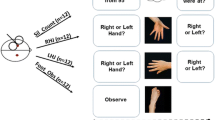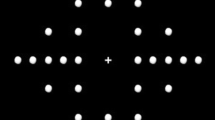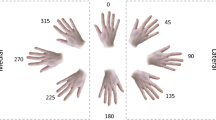Abstract
Mentally simulating a movement is known to share temporal and kinematic characteristics with the execution of the same movement, and this is thought to be reflected in the sharing of neural resources between the two activities. A powerful method of implicitly facilitating such mental simulation (or motor imagery) in individuals is to present them with a picture of a hand and ask them to identify its laterality (i.e. left or right). The mental rotation undertaken in order to complete this hand laterality recognition task (HLRT) provides an effective form of motor imagery, and the task has become an influential tool in clinical and experimental studies. However, performance on the task is modified by numerous factors, and there is a suggestion that the method of response demanded by different versions of the task may have a modulating effect. Here, we compared performance on the HLRT when responding verbally or manually in a group of unimpaired right-handed participants. For manual responses, we also compared performance when participants responded unimanually, using the index and middle fingers of their dominant or non-dominant hand. Performance was poorer for the manual compared to the verbal condition both in terms of accuracy and response time. Furthermore, for manual responses, the requirement to make a response with a specific limb selectively disrupted the ability to recognise an image of the corresponding limb. The disruption is considered to reflect difficulty in concurrently planning two actions with the same limb (manual response and mental rotation). Implications for the interpretation of existing and future studies are discussed.




Similar content being viewed by others
References
Brady N, Maguinness C, Ni CA (2011) My hand or yours? Markedly different sensitivity to egocentric and allocentric views in the hand laterality task. PLoS ONE 6:e23316
Cooper LA, Shepard RN (1975) Mental transformations in the identification of left and right hands. J Exp Psychol Hum Percept Perform 104:48–56
Coslett HB, Medina J, Kliot D, Burkey AR (2010) Mental motor imagery indexes pain: the hand laterality task. Eur J Pain 14:1007–1013
Daprati E, Nico D, Duval S, Lacquaniti F (2010) Different motor imagery modes following brain damage. Cortex 46:1016–1030
de Lange FP, Helmich RC, Toni I (2006) Posture influences motor imagery: an fMRI study. Neuroimage 33:609–617
Fiorio M, Tinazzi M, Aglioti SM (2006) Selective impairment of hand mental rotation in patients with focal hand dystonia. Brain 129:47–54
Ganis G, Keenan JP, Kosslyn SM, Pascual-Leone A (2000) Transcranial magnetic stimulation of primary motor cortex affects mental rotation. Cereb Cortex 10:175–180
Gentilucci M, Daprati E, Gangitano M (1998) Right-handers and left-handers have different representations of their own hand. Cognit Brain Res 6:185–192
Hudson ML, McCormick K, Zalucki N, Moseley GL (2006) Expectation of pain replicates the effect of pain in a hand laterality recognition task: bias in information processing toward the painful side? Eur J Pain 10:219–224
Ionta S, Blanke O (2009) Differential influence of hands posture on mental rotation of hands and feet in left and right handers. Exp Brain Res 195:207–217
Ionta S, Fourkas AD, Fiorio M, Aglioti SM (2007) The influence of hands posture on mental rotation of hands and feet. Exp Brain Res 183:1–7
Johnson SH, Sprehn G, Saykin AJ (2002) Intact motor imagery in chronic upper limb hemiplegics: evidence for activity-independent action representations. J Cognit Neurosci 14:841–852
Kosslyn SM, Digirolamo GJ, Thompson WL, Alpert NM (1998) Mental rotation of objects versus hands: neural mechanisms revealed by positron emission tomography. Psychophysiology 35:151–161
Lameira AP, Gawryszewski LG, Guimaraes-Silva S, Ferreira FM, Vargas CD, Umilta C, Pereira A (2009) Hand posture effects on handedness recognition as revealed by the Simon effect. Frontiers Hum Neurosci 3:59
Lorey B, Bischoff M, Pilgramm S, Stark R, Munzert J, Zentgraf K (2009) The embodied nature of motor imagery: the influence of posture and perspective. Exp Brain Res 194:233–243
McCormick K, Zalucki N, Hudson M, Moseley GL (2007) Faulty proprioceptive information disrupts motor imagery: an experimental study. Aust J Physiother 53:41–45
Moseley GL (2004a) Graded motor imagery is effective for long-standing complex regional pain syndrome: a randomised controlled trial. Pain 108:192–198
Moseley GL (2004b) Why do people with complex regional pain syndrome take longer to recognize their affected hand? Neurology 62:2182–2186
Moseley GL, Sim DF, Henry ML, Souvlis T (2005) Experimental hand pain delays recognition of the contralateral hand—evidence that acute and chronic pain have opposite effects on information processing? Cognit Brain Res 25:188–194
Ni Choisdealbha A, Brady N, Maguinness C (2011) Differing roles for the dominant and non-dominant hands in the hand laterality task. Exp Brain Res 211:73–85
Nico D, Daprati E, Rigal F, Parsons L, Sirigu A (2004) Left and right hand recognition in upper limb amputees. Brain 127:120–132
Parsons LM (1987a) Imagined spatial transformation of one’s body. J Exp Psychol Gen 116:172–191
Parsons LM (1987b) Imagined spatial transformations of one’s hands and feet. Cogn Psychol 19:178–241
Parsons LM (1994) Temporal and kinematic properties of motor behavior reflected in mentally simulated action. J Exp Psychol Hum Percept Perform 20:709–730
Parsons LM, Fox PT (1998) The neural basis of implicit movements used in recognising hand shape. Cognit Neuropsychol 15:583–615
Parsons LM, Gabrieli JD, Phelps EA, Gazzaniga MS (1998) Cerebrally lateralized mental representations of hand shape and movement. J Neurosci 18:6539–6548
Saimpont A, Pozzo T, Papaxanthis C (2009) Aging affects the mental rotation of left and right hands. PLoS ONE 4:e6714
Schwoebel J, Friedman R, Duda N, Coslett HB (2001) Pain and the body schema—evidence for peripheral effects on mental representations of movement. Brain 124:2098–2104
Shenton JT, Schwoebel J, Coslett HB (2004) Mental motor imagery and the body schema: evidence for proprioceptive dominance. Neurosci Lett 370:19–24
Simon JR (1969) Reactions toward the source of stimulation. J Exp Psychol 81:174–176
Takeda K, Shimoda N, Sato Y, Ogano M, Kato H (2010) Reaction time differences between left- and right-handers during mental rotation of hand pictures. Laterality 15:415–425
van Elk M, Craje C, Beeren ME, Steenbergen B, van Schie HT, Bekkering H (2010) Neural evidence for compromised motor imagery in right hemiparetic cerebral palsy. Frontiers Neurol 1:150
Wexler M, Kosslyn SM, Berthoz A (1998) Motor processes in mental rotation. Cognition 68:77–94
Wohlschlager A, Wohlschlager A (1998) Mental and manual rotation. J Exp Psychol Hum Percept Perform 24:397–412
Acknowledgments
We would like to thank three anonymous reviewers for their thoughtful and very helpful comments on the manuscript.
Author information
Authors and Affiliations
Corresponding author
Rights and permissions
About this article
Cite this article
Cocksworth, R.L., Punt, T.D. When the left hand does not know what the left hand is doing: response mode affects mental rotation of hands. Exp Brain Res 228, 87–95 (2013). https://doi.org/10.1007/s00221-013-3540-2
Received:
Accepted:
Published:
Issue Date:
DOI: https://doi.org/10.1007/s00221-013-3540-2




